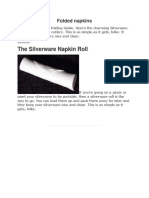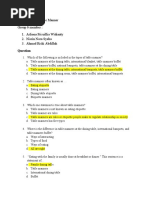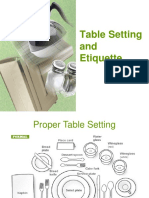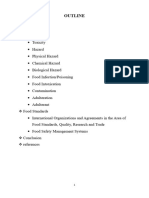Table Setting Guidelines: 1. Informal 2. Informal
Uploaded by
sashellTable Setting Guidelines: 1. Informal 2. Informal
Uploaded by
sashellTABLE SETTING GUIDELINES
1. Informal 2. Informal
Napkins, utensils, and plate are lined up evenly, about A salad plate is placed above the fork and the salad fork to
2.5 cm (one inch) from the edge of the table. The water the left of the dinner fork.
glass is above the tip of the knife
3. Informal 4. Formal
When no knife is needed, the fork may be placed to the With limited table space, the bread and butter plate and the
right of the plate. salad plate can be placed above the napkin and forks. A soup
spoon and milk glass are also added.
1. Napkin 5. Knife 9. Additional beverage glass 13. Salad Plate
2. Salad Fork 6. Spoon 10. Cup & Saucer or mug 14. Iced Tea Spoon
3. Dinner Fork 7. Soup Spoon 11. Bread & Butter Plate
4. Plate 8. Water Glass 12. Butter Spreader
GENERAL BASICS OF TABLESETTING:
1. Attractiveness, convenience, & efficiency are the basic requirements of any tablesetting.
2. The flatware, glassware, china and napkin required for one person is called a "cover", and should cover no more area than 20-24"
left to right nor 15" front to back: 20-24" If using formal tablesetting (#4 above), the arrangement of the cover
may look cramped, but the judge will understand.
15"
3. Use only the tableware required by the menu.
4. Refer to the current tablesetting contest requirements and scoring system in the County Fairbook.
5. Breakfasts and lunches are usually simpler meals with most food items on the same plate. Dinners may be served in courses with
necessary dishes stacked in order of use with first item used on top.
6. Be creative!!
LINEN:
1. Linens used, regardless of kind, ought to be spotless and wrinkle-free.
2. Lay freshly ironed cloth on table so the over-hang is the same at the ends and sides. The center fold line should fall exactly in the
center line of the table. A moderate over-hang gives the best appearance which will depend on the size and shape of the table, but
should not look skimpy. Be sure to step back and look at your tablecloth to make sure it is even all the way around.
3. Lay place mats flush with the table edge or not more than 1/2" from it. On a round table the corners of a rectangular placemat
touch the edge of the table -- a round placement the bottom is flush.
NOTE: Placemats and/or tablecloth and napkins may be used.
Paper or plastic products are NOT acceptable. If your table is
marred, you may cover it with a tablecloth, and then use the
placemats you would normally use.
NAPKINS:
1. Making napkin rings or folding the napkins in a creative way (e.g. fan-shaped) are acceptable. (Napkins are to be folded in front of
the judge during a contest.) One napkin will be folded in the standard rectangular fold for judging. After judging, the remaining
napkin may be folded to match the tablesetting. (diagram)
2. The napkin is laid at the left of covers beside the fork or forks. Specially-folded napkins may be placed on the center of the plate,
etc.
3. Plate, flatware, & napkin should lie in a straight line 1 inch from edge of table or 1/2 inch from edge of placemat. If folded
rectangularly, the napkin is folded and placed with fold away from plate, so napkin will unfold easily onto lap by grabbing corner.
Open edges toward edge of table.
LAYING FLATWARE:
1. Flatware, regardless of quality or design, should be spotless and free of finger prints.
2. Lay clean pieces of flatware, close but not touching. Position flatware in the order of use, from the outside toward the plate.
Include only flatware that will be used. The dinner knife goes to the right of the plate with the cutting edge toward the plate.
Spoons are placed to the right of the knife. Forks are placed to the left of the plate with two exceptions: 1) a seafood fork is placed
to the right of the spoons, and 2) if no knife is used, the fork takes the place of the knife (#3).
3. Flatware should be placed 1 inch from edge of table. When the placemat is placed flush with the table edge, the flatware is placed
1 inch from the edge of the mat. If the mat is 1/2 inch away from the table edge, the flatware is placed 1/2" from the edge of the
mat.
4. A butter spreader is used only in formal dinners and is placed as shown in #4.
5. Include all flatware that will be used for the menu.
DISHES, BEVERAGEWARE:
1. The plate is in the center of the cover.
2. The salad plate is placed directly above the fork. If a bread and butter plate is used for formal dinner, see #4 for proper placement.
3. A bowl of fruit may take the place of the bread and butter plate.
4. The water glass is at the tip of the knife. If another beverage (milk, sparkling cider, juice) is used in addition to the water glass, it is
placed to the right of the water glass and slightly nearer the person eating (see #4).
5. The cup, handle turned parallel to the edge of the table, lies to the right of the bowl or the spoon. If no glass is used, the cup goes
to the right of the tip of the knife and slightly above the spoon.
6. Regardless of quality or design, dishes and beverageware should be spotless and free of fingerprints. After wiping, exteriors of
dishes and beverageware may be handled for placing.
TABLE DECORATIONS:
1. Keep decorations low, in good taste, and in scale with table.
2. Decorations don't always need to be placed in center of table. (Floral designs and centerpieces are to be assembled in front of the
judge during a contest.)
3. With the exception of a tea table, candles should be lit only after dusk and should burn above eye level for the comfort of diners.
(Therefore, for dinners only.)
4. Be creative!!
MENU CARDS:
1. The finished printed menu for the meal must be 5” x 8”.
2. Menu should be neat, centered, and properly organized in the order of the menu. Menu Card must also include the exhibitor's
name, age, 4-H level and club name. Examples:
Dinner
Breakfast Lunch Green Salad with Dressing
Orange Juice Cheeseburger on Bun Grilled Chicken and Wild Rice
Cereal with Milk English Muffin Salad Greens Potato Chips Steamed Vegetables
Fresh Berries Hot Chocolate Melon Rolls with Butter
Iced Tea Cheesecake with Berries
Contestant’s Name Contestant’s Name Sparkling Cider (or Water)
Club Name Club Name Contestant’s Name
Grade Division - Junior Grade Division - Intermediate Club Name
Grade Division (Jr. Int. Sr.)
1986 -- Prepared by Mickie Schuyler, Douglas County 4-H Leader and Home Economist and Sandy Watts, Douglas County/OSU Extension Agent --
4-H and Youth Education and Development
1991 -- Revised by Cherill Tannehill, Douglas County 4-H Leader/Home Economist and Saralyn Johnson, Douglas County OSU Extension Agent,
4-H and Youth Development
1995 -- Revised by Douglas County 4-H Home Economics Committee and Robin VanWinkle, Douglas County OSU Extension Agent, 4-H and
Youth Development
2004 – Revised by Penny Havig and Myrt Thames, Douglas County 4-H Leaders and Robin VanWinkle, Douglas County OSU Extension Agent,
4-H and Youth Development
You might also like
- Hele 5 - Q3 - Week 8: Lesson 4 Food Safety and Sanitation100% (1)Hele 5 - Q3 - Week 8: Lesson 4 Food Safety and Sanitation3 pages
- A Lot Can Happen Over Coffee and Dinner,: But Not If You Have Poor Table Manners!No ratings yetA Lot Can Happen Over Coffee and Dinner,: But Not If You Have Poor Table Manners!13 pages
- Assignment - 6: 1. Selecting The Service TrayNo ratings yetAssignment - 6: 1. Selecting The Service Tray2 pages
- Learning Module in Cookery 12: Lesson 1: Learning Outcomes: - Performance: StandardNo ratings yetLearning Module in Cookery 12: Lesson 1: Learning Outcomes: - Performance: Standard4 pages
- Table Setting and Etiquette PowerPoint Presentation100% (1)Table Setting and Etiquette PowerPoint Presentation22 pages
- Understand The Principles of Basic Table Setting and Meal Service100% (1)Understand The Principles of Basic Table Setting and Meal Service28 pages
- Table Etiquette and Cultural Differences: Chef Julie Ruth Cabatuando-SubaNo ratings yetTable Etiquette and Cultural Differences: Chef Julie Ruth Cabatuando-Suba23 pages
- Preparation in Food and Beverage ServicesNo ratings yetPreparation in Food and Beverage Services15 pages
- Dining Tools and Equipment Reservation ProcessNo ratings yetDining Tools and Equipment Reservation Process6 pages
- Food and Beverage Course Learning ModuleNo ratings yetFood and Beverage Course Learning Module17 pages
- Equipment Required For Making Cocktails Can OpenerNo ratings yetEquipment Required For Making Cocktails Can Opener11 pages
- Restaurant Service Sequence (Part 2) Serving The Order Serving BeveragesNo ratings yetRestaurant Service Sequence (Part 2) Serving The Order Serving Beverages4 pages
- CURRICULUM Food and Beverage Curriculum FinalNo ratings yetCURRICULUM Food and Beverage Curriculum Final107 pages
- Table Setting and Etiquette PowerPoint Presentation PDF100% (1)Table Setting and Etiquette PowerPoint Presentation PDF25 pages
- Retinol in Animal Food: Milk,: Vitamin ANo ratings yetRetinol in Animal Food: Milk,: Vitamin A2 pages
- Primary Exit Profile May/June 2018 Practice Questions: Grade 6 MathematicsNo ratings yetPrimary Exit Profile May/June 2018 Practice Questions: Grade 6 Mathematics12 pages
- Magnesium and Sodium: By: Sashell RobertsNo ratings yetMagnesium and Sodium: By: Sashell Roberts7 pages
- Braising: Group Members: Kay-Ann Edwards Jomonique Smith Elricko MorganNo ratings yetBraising: Group Members: Kay-Ann Edwards Jomonique Smith Elricko Morgan6 pages
- The Ionic Bond: Visit For 100's of Free PowerpointsNo ratings yetThe Ionic Bond: Visit For 100's of Free Powerpoints8 pages
- Connect - 220707 Press Release Amsterdam Commodities Officially Changes Name Acomo NVNo ratings yetConnect - 220707 Press Release Amsterdam Commodities Officially Changes Name Acomo NV2 pages
- The Business of Wine 1st Edition Per V. Jenster 2024 Scribd Download100% (1)The Business of Wine 1st Edition Per V. Jenster 2024 Scribd Download58 pages
- SA3: Service Encounter Report: Name: Panganiban, Alliah R Section: M3ANo ratings yetSA3: Service Encounter Report: Name: Panganiban, Alliah R Section: M3A7 pages
- Faculty of Plantation and Agrotechnology Universiti Teknologi Mara (Uitm) Melaka Branch Jasin Campus AT110No ratings yetFaculty of Plantation and Agrotechnology Universiti Teknologi Mara (Uitm) Melaka Branch Jasin Campus AT11010 pages
- Starter Distillate J Jay Prakash BhartiNo ratings yetStarter Distillate J Jay Prakash Bharti12 pages
- Project Appraisal Document (Pad) - P164319 - May 2018 - Pre - Negs (Recovered)No ratings yetProject Appraisal Document (Pad) - P164319 - May 2018 - Pre - Negs (Recovered)77 pages
- Doctor: Hello MR / MS.. Doctor: Meet You Patient. Hello, Doctor. You: Meet The DoctorNo ratings yetDoctor: Hello MR / MS.. Doctor: Meet You Patient. Hello, Doctor. You: Meet The Doctor13 pages
- Jawapan Experiment Urine Output (Tganu 2012)No ratings yetJawapan Experiment Urine Output (Tganu 2012)29 pages
- Soal UAS Bahasa Inggris Kelas 1 SD Semester 2 Dan Kunci JawabanNo ratings yetSoal UAS Bahasa Inggris Kelas 1 SD Semester 2 Dan Kunci Jawaban4 pages
- [2024-2025] Sensory Evaluation Form (MACARONI SOUP)No ratings yet[2024-2025] Sensory Evaluation Form (MACARONI SOUP)1 page
- SMK Sultan Abdul Jalil, Kluang, Johor (Jea 2033) Pentaksiran Kurikulum 1 (2021) Tingkatan 4 Bahasa Inggeris (1 JAM) Question 1-9No ratings yetSMK Sultan Abdul Jalil, Kluang, Johor (Jea 2033) Pentaksiran Kurikulum 1 (2021) Tingkatan 4 Bahasa Inggeris (1 JAM) Question 1-95 pages



































































































